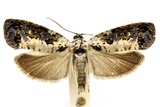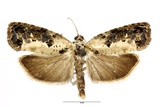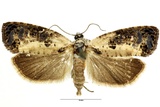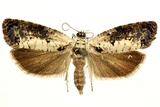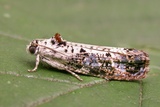Hedya salicella (Linnaeus, 1758) Species
Last modified: Oct. 30, 2025, 8:15 p.m.
A common species throughout Belgium, especially in the northern part.
Details
- Classification
- Family: Tortricidae > Subfamily: Olethreutinae > Tribus: Olethreutini > Genus: Hedya > Species: Hedya salicella
- Vernacular names
- Pinguintje (NL), White-backed Tortrix, White-backed Marble (EN), Weiden-Knospenwickler (DE)
- Synonyms
- Hedya salicana (Denis & Schiffermüller, 1775)
- First mention in Belgium
- De Sélys-Longchamps E. 1844. Énumération des insectes Lépidoptères de la Belgique. — Mémoires de la Société royale des Sciences de Liége 2: 1–35. On page 21.
- Status
-
Native
Distribution
Imago
Wingspan 19–24 mm. The adults, resembling a bird dropping.
Large and distinctive species showing a white thorax and tegula, and large unmarked white dorsal area to forewing. There is a prominent reddish-brown twin scale tuft on the posterior part of the thorax.
It rests with its wings held close to the body.
Caterpillar
The caterpillar is reddish-brown, the warts, the head and the nape are black.
Bionomics
The larva lives in a spun shoot or a folded leaf. Pupation takes place in the larval habitation.
The adults are active from dusk and later come to light.
Flight periods
The adults fly from late May to the end of September, occasionally later.
Observed on
- Host plant (species):
- Salix alba
The larva lives Salix alba, S. caprea, S. fragilis, less frequently on other species of Salix, also on Populus tremula or P. nigra.
Habitat
It inhabits marshy places amongst willows, banks of streams, open woodland and parks and gardens.
